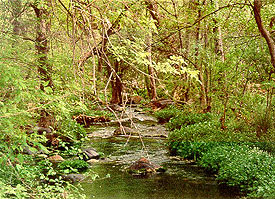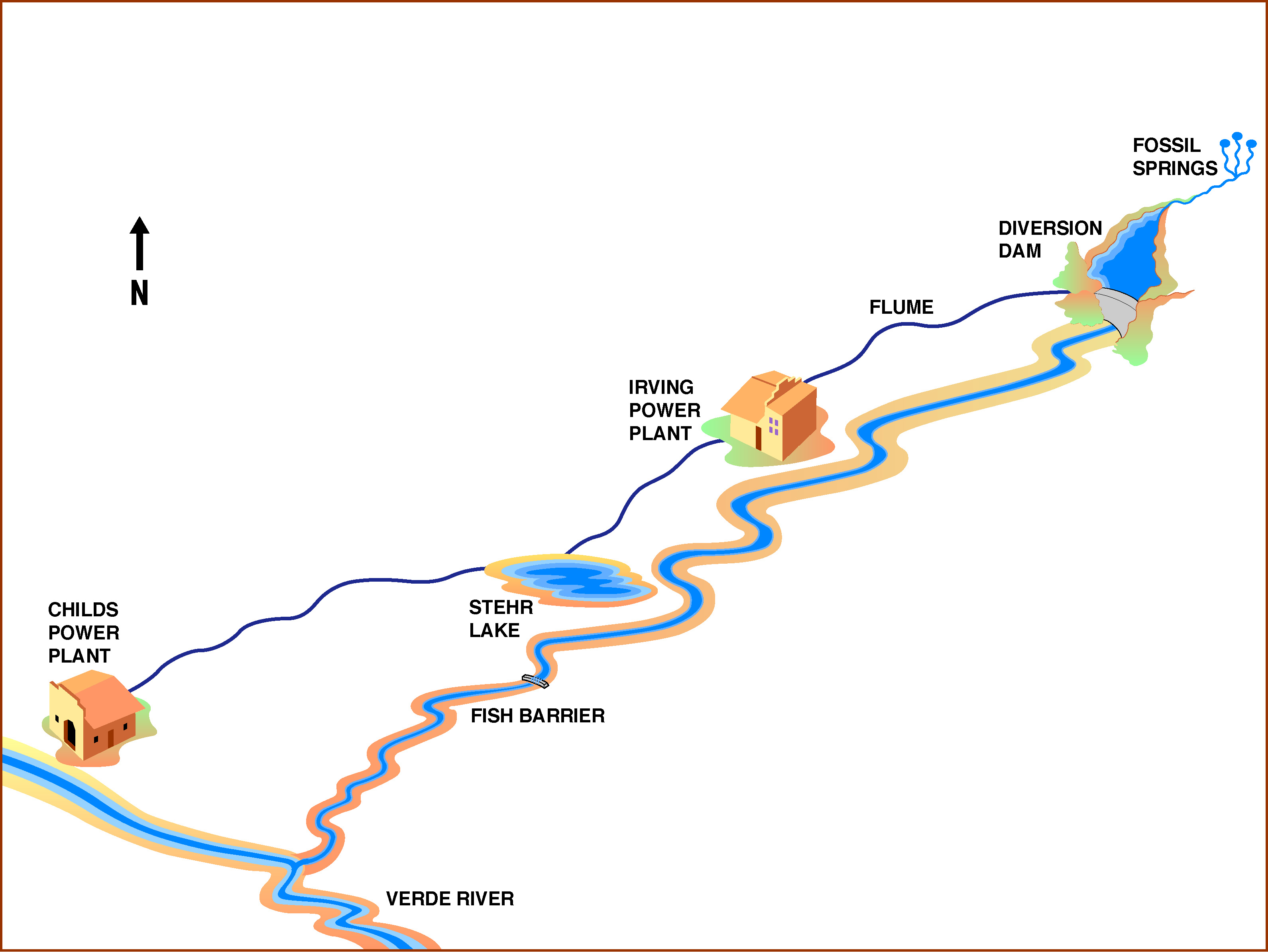|
Fossil
Creek Watershed
and Riparian Restoration
Overview of
Northern Arizona University's Fossil Creek Project: A Comprehensive
Monitoring Plan for Fossil Creek Watershed Restoration

Photo: Corrie Whitney
Fossil Creek provides one of the
best opportunities for riparian restoration in the Southwest, where over 90%
of wetland and riparian areas have been lost or degraded over the last
century. The decision to shut down the Childs-Irving hydroelectric
facilities and restore flow to the creek is important at local, state and
national levels; the ensuing restoration actions can serve as elements of a
model, when restoration is sought for other aging dams around the nation and
elsewhere.

Schematic of Fossil Creek and major
man-made elements, 2005 (Ron Redsteer, NAU)
The success of restoration projects and the
development of restoration ecology depend upon linking on-the-ground
practice with multi-disciplinary sciences, such as hydrology and
geomorphology. Of the thousands of stream restoration activities carried out
each year in the U.S., including a steadily increasing number of dam
removals, only a fraction benefit from the combined insights of
practitioners and scientists. Policy makers approve costly decisions to
restore ecosystems with little ability, or effort, to measure the success of
these actions. Because few dam removal projects have adequate baseline data
to evaluate the effects of restoration, Fossil Creek can serve as a case
study to inform and guide policy and practices surrounding flow restoration,
watershed rehabilitation and facility removal projects. The results will be
applicable to decisions concerning the tens of thousands of small dams that
will be decommissioned in the years and decades to come – both nationally
and internationally.
In March 2004, Northern Arizona University
was awarded a grant by the Nina Mason Pulliam Charitable Trust to begin work
on A Comprehensive Monitoring Plan for Fossil Creek Watershed
Restoration: a Model for Decommissioning Hydropower Facilities in the 21st
Century.
This grant allowed NAU to underwrite the first
year of a multi-year project to provide
recommendations, assess progress and catalyze NAU involvement in the
restoration of the Fossil Creek stream and watershed. In March 2005, NAU was
awarded a second year of funding from the Nina Mason Pulliam Trust to carry forward our
monitoring and coordination work to assess the effects of the return of full
flows on aquatic wildlife, hydrogeological systems, and human recreation. A
third and final year of funding was awarded to NAU in March 2006 by the
Pulliam Trust.
For more information about NAU's work at
Fossil Creek, open the following files. Also, check out the Research
section of this web site.
Restoring Fossil Creek: A Collaborative Effort, Michele James, Fossil
Creek Project Coordinator, NAU (published in Southwest Hydrology,
November/December 2005)
PDF(1.08 MB)
Fossil
Creek State of the Watershed Report (July 2005)
PDF (14.3 MB)
A Comprehensive Monitoring Plan for Fossil Creek
Watershed Restoration: Background on the Pulliam Trust Project, Year 1
(2004-2005)
Word document (57 KB)
PDF (53 KB)
NAU Helping to Restore Fossil Creek (PDF)(24 KB) (Inside NAU, June 16, 2004)
Home
Baseline Conditions
Long-Term Monitoring Plan
Participatory Meetings
Facility Decommissioning
Management Recommendations
Forest Service Fossil Creek Info
Native Fish Restoration
Research
Photos
Links
|
